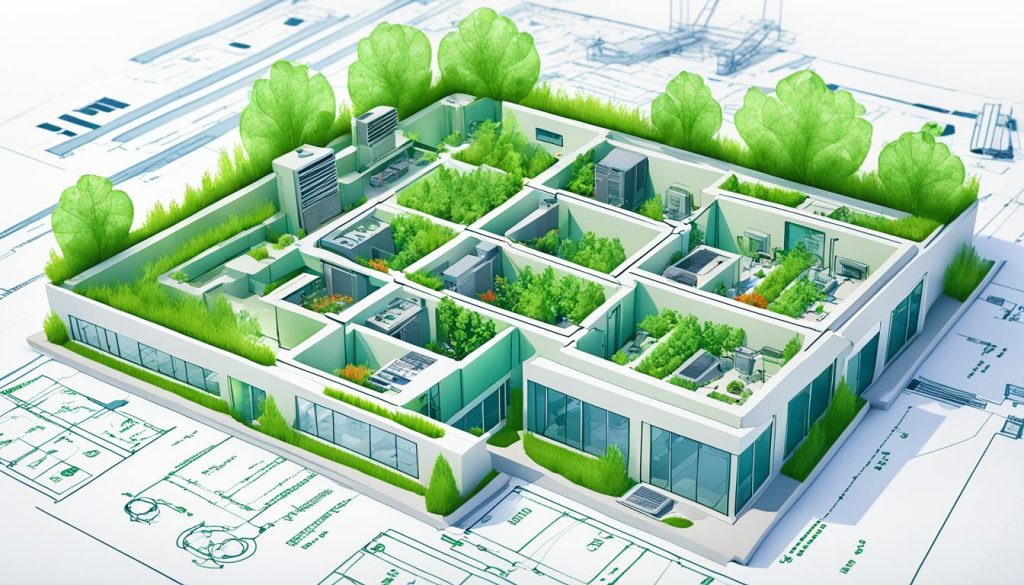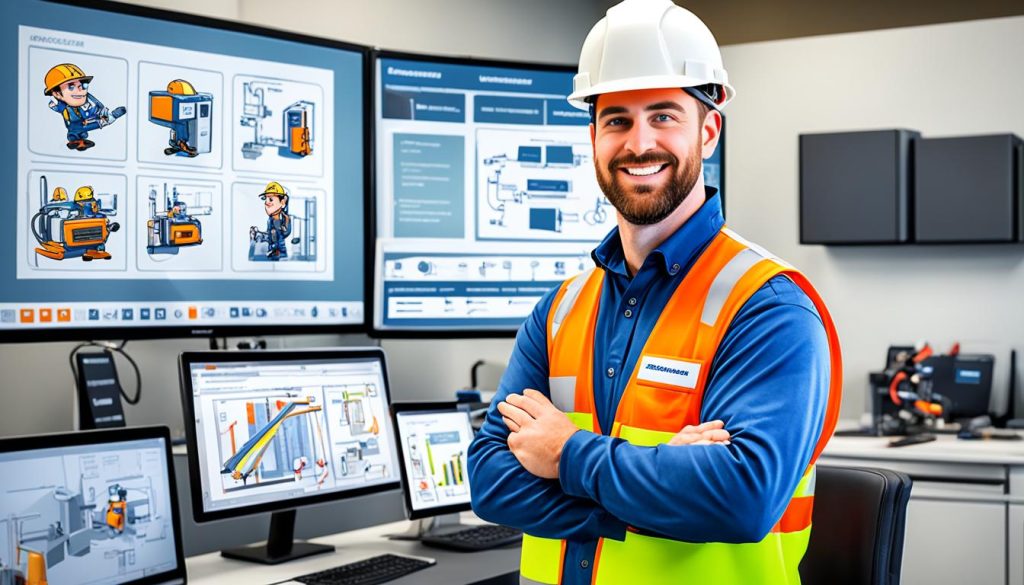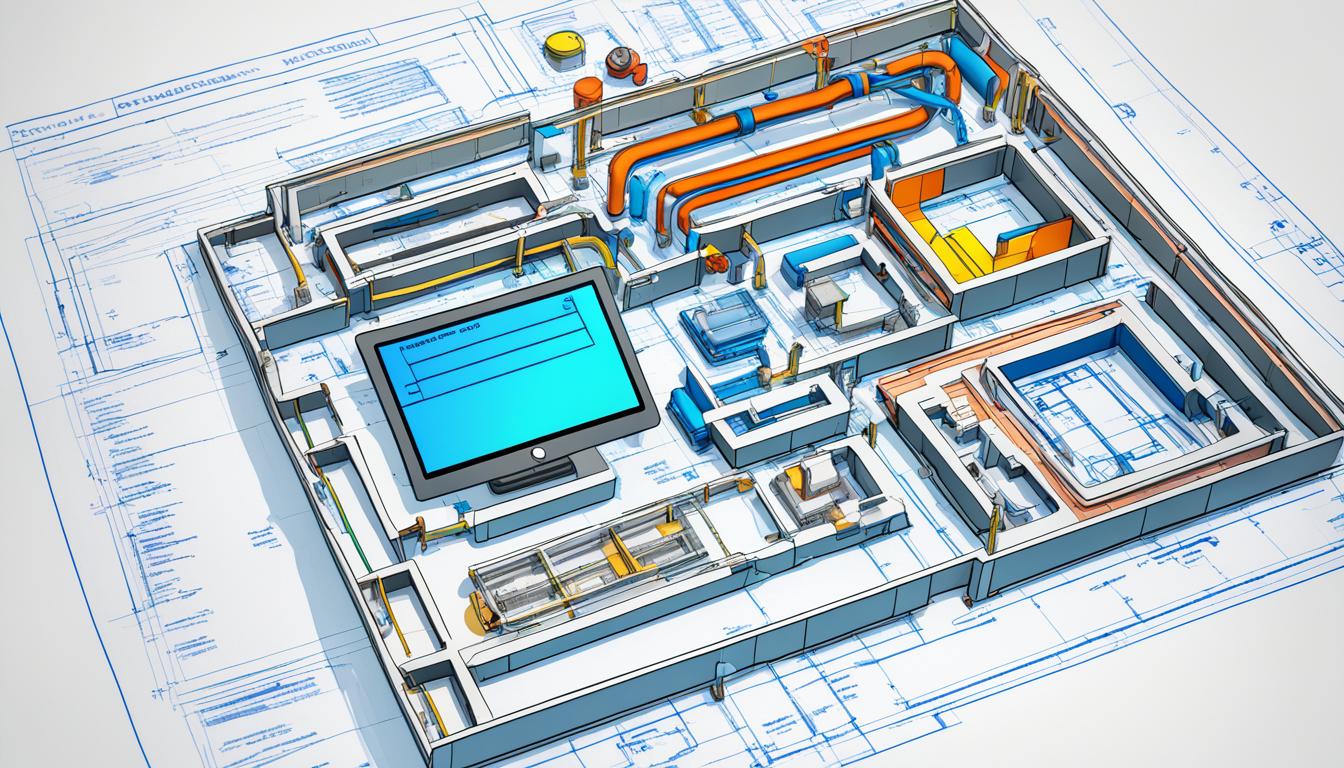You can plan HVAC prefabrication with CAD software to make installations more efficient. This method uses digital modeling and offsite fabrication to improve your HVAC design process. With specialized computer-aided design tools, you can make detailed layouts for complex ductwork and piping before starting construction.
CAD software for HVAC has powerful tools to help you optimize your designs. You can use libraries of standardized parts, do thermal load calculations, and check energy use. This digital method lets you spot problems early, cutting down on costly fixes later. By working with Building Information Modeling (BIM) systems, you’ll make sure your HVAC systems work well with the rest of the project.
Understanding HVAC CAD Software and Its Importance
HVAC CAD software changes how we design and put together heating, ventilation, and air conditioning systems. It lets engineers and designers make exact digital blueprints. This makes the HVAC planning process smoother.
Definition and Core Features of HVAC CAD Software
HVAC CAD software is a special computer program for designing HVAC systems. It has key features like:
- 3D modeling for ductwork design
- Automated load calculations
- Tools for picking equipment
- Functions for energy analysis
Benefits of Using Specialized Software for HVAC Design
Using HVAC CAD software brings many benefits:
- More accurate system layouts
- Better construction productivity with precise planning
- Fewer mistakes and less rework during setup
- Improved teamwork between design teams and contractors
Integration with Building Information Modeling (BIM)
HVAC CAD software works well with BIM modeling. This makes a full digital model of the building. This teamwork leads to:
- Smarter coordination with other building systems
- Finding clashes early to avoid problems
- Better project visuals for everyone involved
- Sharing data easily across different teams
With HVAC CAD software and BIM, you can make your design process better. You’ll work more efficiently and deliver top-notch HVAC systems for today’s building projects.
Revolutionizing HVAC Design with Precision and Accuracy
HVAC design has changed a lot with new CAD software. Now, making complex ductwork and piping takes hours, not days. This big change comes from the precision and accuracy of digital tools.
Thanks to digital fabrication, HVAC design is faster. Engineers can quickly change designs as projects change. This means they can quickly adapt to what clients need and what the site is like.
Software lets many users work on one project at the same time. This makes teams work better together, no matter where they are. It cuts down on misunderstandings and boosts work speed.
| Traditional HVAC Design | CAD-Driven HVAC Design |
|---|---|
| Time-consuming manual calculations | Rapid automated computations |
| Limited collaboration options | Real-time multi-user editing |
| Difficult to modify designs | Easy adjustments and iterations |
HVAC CAD software is great for sustainable building. It lets you simulate how systems will work in real life. This helps you pick the best, greenest options for your projects.
- Optimize airflow for better indoor air quality
- Reduce energy use with accurate equipment sizing
- Add renewable energy to HVAC systems
Using these advanced tools, you’re not just designing HVAC systems. You’re making indoor spaces that are comfy, efficient, and good for the planet.
Streamlining Collaboration Between Engineers and On-Site Teams
HVAC CAD software changes how engineers and on-site teams work together. It makes construction work better by making sure information flows smoothly from design to installation.
Real-time Updates and Communication
Digital blueprints let you share project changes instantly. You can adjust plans and see updates on all devices right away. This cuts down on misunderstandings and keeps the team in sync.
Reducing Errors Through Digital Precision
Digital blueprints offer unmatched accuracy in HVAC designs. These accurate plans help avoid mistakes during installation, saving time and money. On-site teams can use detailed 3D models to make sure everything fits right the first time.
Facilitating Off-site Fabrication
HVAC CAD software makes offsite fabrication possible, which is a big win for construction efficiency. You can design complex parts digitally and make them in controlled places. This leads to better quality parts and quicker assembly on-site, speeding up the whole project.
- Create precise component specifications
- Coordinate with fabrication shops easily
- Reduce on-site storage needs
- Minimize waste and improve sustainability
Using these features changes your HVAC projects for the better. The smooth blend of design, communication, and fabrication means smoother installations and better results.
Enhancing Green Building Designs Through HVAC CAD Software
HVAC CAD software is changing the game for green building design. It lets you make energy-saving HVAC systems that fit with sustainable building methods. With advanced simulation tools, you can improve building performance even before starting construction.
Green building designs get a big boost from HVAC CAD software. It lets you model natural ventilation, solar heat, and thermal mass with precision. This means you can cut down on energy use and use more renewable energy.

Adding renewable energy sources to HVAC systems is easy with CAD software. You can put solar panels or geothermal systems into your designs. This ensures they work well with the building’s energy plan.
HVAC CAD software helps meet environmental standards. It makes it easier to get LEED or BREEAM certifications by providing detailed energy performance analysis and documentation.
| Feature | Benefit for Green Building Design |
|---|---|
| Energy Simulation | Optimizes building performance |
| Renewable Energy Integration | Facilitates solar and geothermal system design |
| Thermal Analysis | Improves natural ventilation strategies |
| Certification Support | Streamlines LEED and BREEAM compliance |
Using HVAC CAD software in green building projects means more than designing buildings. It’s about creating sustainable environments. This tech connects innovative ideas with practical, energy-saving solutions. It’s leading the way to a greener future in building.
3D Modeling Excellence in Spatial Planning for HVAC Systems
3D modeling changes the game in HVAC system design. It boosts spatial planning and boosts efficiency. This tech lets you see and fine-tune your HVAC parts in a virtual space before you start building.
Improving Spatial Awareness and Component Placement
3D modeling software shows your HVAC system in the building’s layout. It helps you place parts better. You can see how everything fits together, making sure you use space well and avoiding clashes.
Clash Detection and Resolution
3D modeling’s clash detection is a big plus. It finds conflicts between HVAC parts and other building systems early. This way, you can fix problems in a virtual space, saving time and money later on.
Optimizing Ductwork and Piping Layouts
3D modeling is great for ductwork optimization. You can design and test layouts to find the best paths for air and fluids. This cuts down on materials, energy loss, and boosts system performance.
| Aspect | 2D Design | 3D Modeling |
|---|---|---|
| Spatial Awareness | Limited | Enhanced |
| Clash Detection | Manual | Automated |
| Layout Optimization | Time-consuming | Efficient |
| Visualization | Basic | Realistic |
Using 3D modeling for spatial planning leads to better, cheaper, and more reliable HVAC systems. This tech makes designing easier and helps avoid mistakes during installation.
Plan HVAC Prefabrication Using CAD Software for Installation Efficiency
CAD software changes the game for HVAC prefabrication, making installations faster. You can design parts and plan how they fit together off-site. This cuts down the time spent on installation and lowers the chance of mistakes.
Using CAD for HVAC prefabrication means you can model things accurately. This means the parts fit just right when you put them together, cutting down on changes and mistakes. It makes the whole installation smoother and quicker.

With CAD, offsite fabrication gets a boost. You can make detailed digital models of HVAC systems, like ducts, pipes, and equipment. These models help make sure every part is made just right before it’s put together.
The perks of CAD for HVAC prefabrication are many:
- Less on-site labor costs
- Better quality control
- Less material waste
- Improved project scheduling
- Enhanced coordination among teams
Here are steps to make HVAC prefabrication with CAD more efficient:
- Do thorough site surveys
- Make detailed 3D models of the HVAC system
- Look for parts that can be prefabricated
- Design components that are easy to put together
- Make exact drawings for fabrication
Using CAD for HVAC prefabrication makes the installation smoother and saves time and money on your projects.
| Metric | Traditional Method | CAD-Driven Prefabrication |
|---|---|---|
| Installation Time | 100 hours | 60 hours |
| Labor Costs | $10,000 | $6,000 |
| Material Waste | 15% | 5% |
| Quality Control Issues | 10 per project | 2 per project |
Leveraging CAD Software for Precise HVAC Component Fabrication
CAD software changes the game in HVAC component fabrication. It makes the process more precise and efficient. From design to installation, it ensures HVAC systems work their best.
Creating Detailed Shop Drawings
Shop drawings are key for making HVAC parts. With CAD software, you can make detailed drawings. They include exact sizes, material details, and how to put things together.
These detailed plans cut down on mistakes and make making parts easier.
Generating Accurate Bill of Materials
Getting the right parts is key for HVAC projects. CAD software makes a detailed list of what you need. It tells you how many and what each part is.
This helps avoid extra materials, makes sure you have everything, and keeps costs in check.
| Component | Quantity | Specification |
|---|---|---|
| Ductwork | 500 ft | Galvanized steel, 24 gauge |
| Air Handlers | 3 | 15,000 CFM capacity |
| Dampers | 20 | Fire-rated, motorized |
Customizing Prefabricated Elements
CAD software lets you customize HVAC parts. You can make them fit your project needs while keeping things standardized. This makes putting things together faster, improves quality, and boosts installation efficiency.
Using CAD software for HVAC parts makes projects better. It’s precise in making plans, lists parts, and supports custom parts. This leads to smoother installs and HVAC systems that work well.
Improving Installation Efficiency with CAD-Driven Prefabrication
CAD-driven prefabrication is changing how we install HVAC systems. It uses computer-aided design to make parts that fit together easily on-site. This method cuts down on installation time and lowers labor costs, making your projects more profitable.
With CAD-designed parts, there’s less need for adjustments on the job. Your team can put together components fast, leading to quicker HVAC installations. This approach not only speeds up the work but also makes it safer. With more work done off-site, there’s less risk of accidents during construction.
Modular construction, thanks to CAD technology, is a game-changer for HVAC pros. Prefabricated units come ready to install, lowering the risk of mistakes and speeding up projects. This efficient way of working lets you take on more jobs and boost your profits while delivering great HVAC systems to your clients.





0 Comments